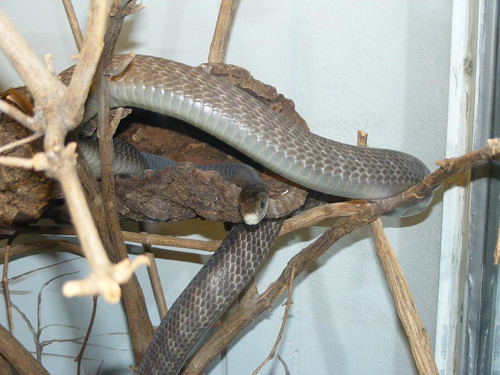The Black Mamba (Dendroaspis polylepis), is an elapid snake and is Africa's most dangerous and feared snake. It has a wide range of known locations throughout Africa. The black mamba is native to Somalia, Egypt, Ethiopia, Kenya, Tanzania, Botswana, Uganda, Zambia, Zimbabwe, Angola, Namibia, Malawi, Mozambique, South Africa, Swaziland, and the Congo. They inhabit a wide variety of areas that include open savannahs, open woodlands, and rocky outcrops. It is also known for being very aggressive when disturbed or confronted and will not hesitate to strike with deadly precision.
The black mamba is the largest venomous snake in Africa and the second longest venomous snake in the world, after the King Cobra. Adult black mambas have an average length of 2.5 meters (8.2 ft) and a maximum length of 4.5 meters (~14 ft). Like all other reptiles, the black mamba relies on external heat to regulate the temperature of its body.
The Black Mamba is also the fastest land snake in the world, able to reach speeds in excess of 12 miles per hour (20 km/h). However it uses this speed to escape danger, rather than catch prey.
The name "black mamba" is somewhat confusing because that is not the snake's actual color. Its body is not black at all; the name is given to it because of its inky black mouth. Normally, mambas have a dark olive, olive green, grey brown, or metal color. Some of them have a light band around their body. As mambas get older, their skin begins to darken.
The black mamba is the largest venomous snake in Africa and the second longest venomous snake in the world, after the King Cobra. Adult black mambas have an average length of 2.5 meters (8.2 ft) and a maximum length of 4.5 meters (~14 ft). Like all other reptiles, the black mamba relies on external heat to regulate the temperature of its body.
The Black Mamba is also the fastest land snake in the world, able to reach speeds in excess of 12 miles per hour (20 km/h). However it uses this speed to escape danger, rather than catch prey.
The name "black mamba" is somewhat confusing because that is not the snake's actual color. Its body is not black at all; the name is given to it because of its inky black mouth. Normally, mambas have a dark olive, olive green, grey brown, or metal color. Some of them have a light band around their body. As mambas get older, their skin begins to darken.


No comments:
Post a Comment